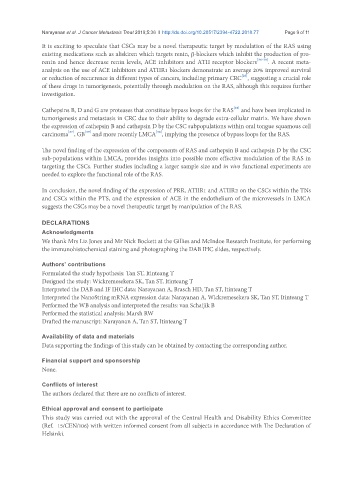Page 66 - Read Online
P. 66
Narayanan et al. J Cancer Metastasis Treat 2019;5:36 I http://dx.doi.org/10.20517/2394-4722.2018.77 Page 9 of 11
It is exciting to speculate that CSCs may be a novel therapeutic target by modulation of the RAS using
existing medications such as aliskiren which targets renin, β-blockers which inhibit the production of pro-
renin and hence decrease renin levels, ACE inhibitors and ATII receptor blockers [36-38] . A recent meta-
analysis on the use of ACE inhibitors and ATIIR1 blockers demonstrate an average 20% improved survival
[29]
or reduction of recurrence in different types of cancers, including primary CRC , suggesting a crucial role
of these drugs in tumorigenesis, potentially through modulation on the RAS, although this requires further
investigation.
[22]
Cathepsins B, D and G are proteases that constitute bypass loops for the RAS and have been implicated in
tumorigenesis and metastasis in CRC due to their ability to degrade extra-cellular matrix. We have shown
the expression of cathepsin B and cathepsin D by the CSC subpopulations within oral tongue squamous cell
[34]
[39]
[27]
carcinoma , GB and more recently LMCA , implying the presence of bypass loops for the RAS.
The novel finding of the expression of the components of RAS and cathepsin B and cathepsin D by the CSC
sub-populations within LMCA, provides insights into possible more effective modulation of the RAS in
targeting the CSCs. Further studies including a larger sample size and in vivo functional experiments are
needed to explore the functional role of the RAS.
In conclusion, the novel finding of the expression of PRR, ATIIR1 and ATIIR2 on the CSCs within the TNs
and CSCs within the PTS, and the expression of ACE in the endothelium of the microvessels in LMCA
suggests the CSCs may be a novel therapeutic target by manipulation of the RAS.
DECLARATIONS
Acknowledgments
We thank Mrs Liz Jones and Mr Nick Bockett at the Gillies and McIndoe Research Institute, for performing
the immunohistochemical staining and photographing the DAB IHC slides, respectively.
Authors’ contributions
Formulated the study hypothesis: Tan ST, Itinteang T
Designed the study: Wickremesekera SK, Tan ST, Itinteang T
Interpreted the DAB and IF IHC data: Narayanan A, Brasch HD, Tan ST, Itinteang T
Interpreted the NanoString mRNA expression data: Narayanan A, Wickremesekera SK, Tan ST, Itinteang T
Performed the WB analysis and interpreted the results: van Schaijik B
Performed the statistical analysis: Marsh RW
Drafted the manuscript: Narayanan A, Tan ST, Itinteang T
Availability of data and materials
Data supporting the findings of this study can be obtained by contacting the corresponding author.
Financial support and sponsorship
None.
Conflicts of interest
The authors declared that there are no conflicts of interest.
Ethical approval and consent to participate
This study was carried out with the approval of the Central Health and Disability Ethics Committee
(Ref. 15/CEN/106) with written informed consent from all subjects in accordance with The Declaration of
Helsinki.

